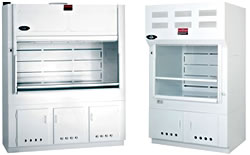Recent News & Events
Choose the Right Type of Fume Hood for Your Laboratory Needs!
28
 In this article you will find out about the different types of chemical fume hoods and the level of protection against noxious chemical fumes they each provide. After reading this article you will gain an understanding of how the different types of fume hood work so you can choose the best design for your laboratory experiments.
In this article you will find out about the different types of chemical fume hoods and the level of protection against noxious chemical fumes they each provide. After reading this article you will gain an understanding of how the different types of fume hood work so you can choose the best design for your laboratory experiments.
The types of chemical fume hood to be discussed in this article are the ducted fume hoods as they are the most common fume hoods available on the market today. The products available are the constant air volume (CAV), the reduced air volume (RAV) and the variable air volume (VAV) chemical fume hoods.
Chemical fume hoods work by extracting air and noxious fumes away from the user and out of the fume hood where the air is filtered and returned to the outside environment by means of a duct system. User protection is enhanced by a movable sash that can be raised or lowered based on the needs of the user. All three types work in a very similar way, differentiated only by their air flow properties.
Constant Air Volume (CAV)
CAV fume hoods exhaust the same amount of air, all of the time, and provide a stable and constant air flow with no need for re-balancing. The most common types contain a bypass opening which allows the air flowing through the hood to remain constant (wherever the sash is placed). Bypass openings are also used to combat the air velocity issues that can occur with conventional fume hoods. Also, because the fume hood has a constant operating procedure, the energy consumption remains constant. Non-bypass fume hoods do not contain this opening so the sash can only be closed to a certain degree. This can cause the air velocity to increase to such amounts that it can disturb your equipment and materials.
Reduced Air Volume (RAV)
New developments in fume hood technology has allowed new features such as sash stops, horizontal sliding sashes, airflow sensors and small fans to be implemented into the design. This advancement has produced the RAV and VAV ranges which have been found to significantly reduce energy consumption.
RAV’s have all the basic principles that CAV’s do but the bypass opening is partially blocked off causing a reduction in airflow which lowers their energy consumption. The downside of this reduction in airflow is that there’s the potential that some of the noxious fumes could escape the fume hood so they can only be used with less noxious compounds.
Variable Air Volume (VAV)
VAV’s are essentially a more advanced version of CAV’s and are becoming the fume hood of choice due to their airflow versatility. In VAV fume hoods, the air flow is kept constant but the velocity can be changed to meet your requirements. VAV fume hoods regulate the air flow based on the sash height to maintain a given velocity at any sash height. This gives you control of the amount of air you want exhausted from your fume hood without worrying about any drop in air velocity. They have also been designed to be very user friendly and all parts that need to be changed periodically are easily accessible to you.
